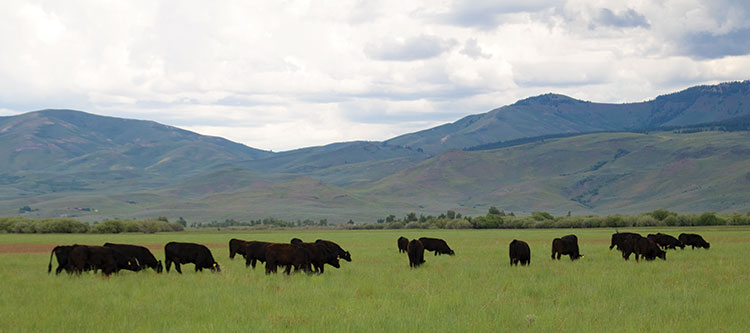
In the past, agriculture was a vocation learned mainly through family ties. However, little headway has been made to create practical, hands-on learning opportunities for individuals from non-ag backgrounds to enter careers in farming or ranching. New Mexico-based Quivira Coalition seeks to remedy this fact for farm and ranch newcomers with their New Agrarian Program (NAP).
NAP provides participants with the chance for hands-on education and mentorship through structured eight-month long apprenticeships with partnering mentor farms and ranches across states such as New Mexico, Colorado, Montana, and California. Founded in 2008, approximately 44 apprentices have gone through the NAP ranks to date.
“The program is unique in that we focus our efforts on providing opportunities for people who are interested in learning how to ranch on large-scale, regenerative ranches in the interior West,” said Alexis Bonogofsky, northern coordinator for the NAP. “Our positions are paid, housing is provided, and some board along with perks through Quivira.”
During their time in the program, apprentices receive around 400 to 600 direct contact hours with their mentor and 1,200 to 1,600 training hours over an eight-month period of six-day workweeks. Most apprentices begin their tenure in the spring (April) and stay on through fall. Bonogofsky conducts site visits before and during the apprenticeship, as well as monthly check-ins with both mentors and apprentices.
“We want the apprentices and mentors to have a quality experience so we spend a significant amount of time with them,” said Bonogofsky. “We also provide supplemental education and training to ranchers and farmers on how to be a good mentor.”
Along with ample chances for hands-on learning and guidance from skilled mentors, Quivira’s NAP stands out with its broad curriculum. Unlike many other on-farm apprenticeship or internship programs, it covers not only production-focused topics, but also financial and business planning, at-scale land stewardship, animal husbandry, equipment operation, and leadership. This additional content is handled through both online courses and in-person learning.
Apprentices also have the chance to visit other operations to gain exposure to different perspectives and practices. The program culminates with a trip to Quivira’s annual conference where apprentice graduation takes place.
No experience needed
Apprentice Kate Clyatt is a recent participant in the New Agrarian Program. Before NAP, she had attended college for natural resource degrees and worked for a brief time as a ranch forestry consultant. These experiences reignited her interest in ranching and led her to find Quivira’s program.
“I didn’t have any direct connections to ranches I could work at, so like every good millennial, I turned to Google,” said Clyatt. “I eventually found a posting for an apprenticeship in New Mexico through ranchworldads.com. Turns out, it was with one of the ranches participating in the New Agrarian Program. NAP appealed to me because it was geared toward people with little or no agricultural background. I was looking for a place where I could learn and would feel comfortable in my inexperience.”
After finishing her New Mexico stint in 2018, Clyatt continued her learning journey by applying to NAP for a second year, this time around with the Mannix Ranch in Helmville, Mont.
Looking back on her overall experience in the program, Clyatt said, “The last two years have been nothing but learning. Many of these lessons have been tangible (for example, horsemanship, low-stress livestock handling, and equipment operation). Constantly being faced with new skill sets has been incredibly rewarding, and I’ve come to love the process.”
However, Clyatt points out that most of the things she learned, like communication, humility, and open-mindedness, have been less tangible.
“While those things are harder to pinpoint, they make life a lot easier and have provided a lot of value to my life, let alone any future endeavors,” Clyatt said.
She pointed out that being an apprentice doesn’t come without some challenges, many of which are reflective of those that come with a life in ranching.
“There are never enough hours in the day or dollars in the bank, and never an end to work,” said Clyatt. “Ranches can be isolating but also incredibly fulfilling. Relationships are close, and that brings out the best and worst in everyone. What I’ve appreciated most about the ranching life is the rawness of it all. It’s a vividly authentic experience, with all of the ups and downs. In my experience, there have been far more ups than downs.”
Quivira accepts new applications to the New Agrarian Program annually starting in mid-October. In addition, the organization offers informational call sessions and introductory field days throughout the year at mentor ranches to give potential apprentices the occasion to see if the program might be right for them.
To those considering the NAP, Clyatt said, “I think it’s a great way to test out the waters. Eight months may seem like a long time to dip a toe, but it’s the best way to understand the whole annual cycle of a farm or ranch. Plus, you can take advantage of conferences and land workshops, as well as the entire network of farmers and ranchers across the West for employment opportunities after the end of the apprenticeship.”
Learn more about the Quivira’s New Agrarian Program at quiviracoalition.org/newagrarian
This article appeared in the January 2020 issue of Hay & Forage Grower on page 32.
Not a subscriber? Click to get the print magazine.

